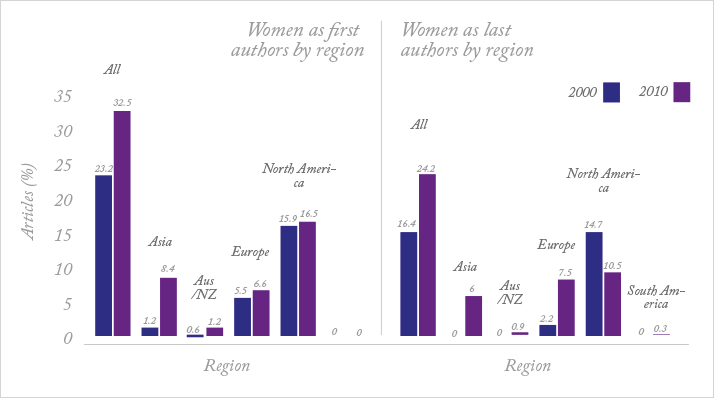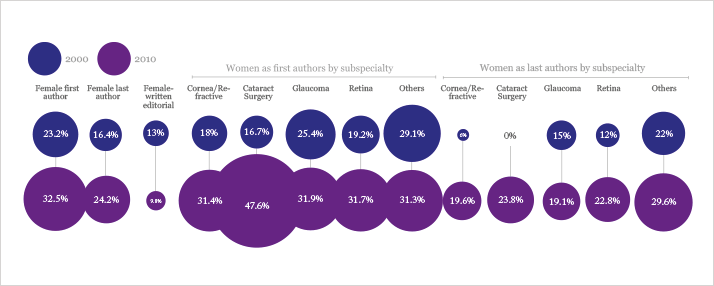
- Women are an ever-increasing segment of the medical workforce, but are far less commonly seen in leadership roles than men
- Combining personal and professional priorities is often more difficult for women than for men in similar positions
- Women don't receive the same degree of quality or sponsorship in their mentoring as men
- Encouraging and promoting women in high-level careers improves an organization's performance and chances of success
Women are a rising force in medicine worldwide, but this is particularly evident in American ophthalmology, where nearly as many women as men are now graduating. In Europe, women make up 58 percent of physicians under the age of 35 in France; 64 percent in Spain; and 54 percent in the UK, where they are expected to outnumber male doctors by 2017 (1). In the United States, women comprise 34 percent of physicians and surgeons and 37 percent of medical school faculty, but 48 percent of medical graduates (2), suggesting a more even split in the future. It’s good news that more people are realizing – and acting on the fact – that women have the same intelligence, education and commitment to their chosen professions as men. But even as this kind of progress is made, the top positions in today’s businesses, clinical practices, and professional societies, are still dominated by men. Women can and do make a difference in the workplace – that’s certainly evidenced in the data presented by McKinsey and Company in their 2013 Women Matter report (3), in which they explained that:
- Companies with women in executive leadership significantly outperform those without.
- Companies with women at the top show a 47 percent higher return on equity and 55 percent greater average earnings.
- Diversity of thought drives innovation. When it isn’t only men discussing issues, the debate often leads to better solutions.
- Companies are becoming more sensitized to increasing the number of women in leadership positions.
With data like this to demonstrate the clear benefits of including women in leadership roles, it’s important to ask ourselves why there are so few women in senior-level positions. We need to identify the things that are keeping women away from executive roles, proactively seek ways to help them achieve their goals and, as a result, contribute not only to the advancement of women but also to the success of their professions and organizations.
What’s holding women back?
The workplace barriers that women face may be fewer than they were in earlier decades, but there’s no doubt that they still exist. Two particularly noteworthy ones are: 1. Balancing personal and professional goalsMany women find it difficult to integrate personal and professional goals in ways that don’t disrupt or diminish professional advancement – especially women who want to excel in both motherhood and career.
This gets even more complicated for women who take a hiatus from work to spend some time at home, whether it’s to start a family, watch children grow up, or pursue personal or academic interests. Taking time off from a career prevents many women from making the advancements that full-time employment or clinical practice can offer. As one woman told me, “Returning to work after taking time off to be a mother was like ‘starting over,’ and there was no way I could compete with others who had worked during the time I stayed at home.” Setbacks like this may explain, to some degree, why many women achieve management positions, but don’t rise to the top.
Across the European Union, women are outnumbered by men in management positions in all fields. Though worse in corporate business, where women represent only 14 percent of board members of major companies and 5 percent of chairpersons (4), women are significantly underrepresented in all positions of responsibility. An American study showed that only 41 percent of women in medicine have at least partial ownership of their practice, compared with 59 percent of men; although women comprise 37 percent of medical school faculty, only 20 percent are full professors (2). For the many women who face the challenge of balancing home and work, the choice to develop their personal lives is not an easy one! 2. Inadequate mentorship and support
Women are not necessarily mentored and supported in the same ways as men and are therefore not as likely to be groomed for top positions.
A 2010 article in the Harvard Business Review, “Why Men Still Get More Promotions Than Women,” cited a 2008 survey of over 4,000 high-potential individuals (women and men) whose results indicated that, although women received more mentoring than men, they were less likely to advance in their careers (5). Men and women had different kinds of mentors; 78 percent of men were actively mentored by senior executives, compared with 69 percent of women, and nearly twice as many women as men had junior-level mentors. Unfortunately, a mentor’s seniority affects the pace of the mentee’s career advancement – a fact borne out by the 2010 follow-up survey, which revealed that men had received 15 percent more promotions in that time than women.
The key is to recognize that mentoring and sponsorship are not the same thing, and women are not actively sponsored in the same ways as men. Unlike mentors, sponsors go above and beyond when giving advice and feedback . They find ways to actively engage their mentees in important projects and make them visible to key leaders who can assist with their development. One man recalls, “My boss said, ‘You are ready for a general management job. You can do it. Now we need to find you a job: What are the tricks we need to figure out? You have to talk to this person and to that one and that one’,” (5). But few women get this kind of support when seeking higher-level jobs, because they’re still seen as “risky” appointments.
What can we do?
The Women Matter report suggests that women need more engagement and support from men to raise awareness and promote gender equality. Though three-quarters of men feel that diverse leadership teams result in better performance, nearly one-third aren’t aware of the difficulties women face when aiming for the top (3). Because men currently have the strongest voice, it’s important to get them on board with initiatives for equality and diversity. To make work-life balance easier for women in fast-paced environments, we need to establish environments geared toward helping them succeed – with strong management commitment to gender diversity, programs to develop women as leaders, and good human resources policies and processes. It isn’t enough simply to offer initiatives like flexible scheduling, because accommodations like those are seen as incompatible with top-level careers (3); we need to address gaps that exclude women from the ground up. Women should not only be encouraged to enter high-level fields but, once there, should be provided with the same sponsorship and services that are available to men. Though it’s clear that women still have far to go in achieving workplace equality, they are making great strides. As societal and cultural norms shift to a place where everyone is equally valued and respected for their knowledge, abilities and ambition, there will be greater opportunities for women to reach top positions. Additionally, as new generations of women and men work together to find solutions where they can express and achieve their personal and professional aspirations, all genders will feel a new sense of freedom and accomplishment to become who they were meant to be.Marsha Link is president of Ophthalmic Women Leaders. She is principal of Link Consulting, a firm specializing in executive coaching, leadership development and practice management. Ophthalmic Women Leaders (OWL) is an organization for the advancement of women across ophthalmology. Founded more than 10 years ago, the women-led group offers programs, events and online resources for individual and collaborative development. More information is available at OWL’s website, http://www.owlsite.org
More women have been entering the profession for decades – but is that being reflected in the literature? By Mark Hillen and Michael Schubert Over recent decades, ever-greater numbers of women have entered the medical profession. A group of researchers in the US and Mexico decided to determine if that has filtered through into the literature, comparing the authorship gender balance of publications in three high-impact ophthalmology journals over two time periods, a decade apart: 2000, and 2010.
Three journals assessed: Ophthalmology, Am. J. Ophthalmol., and JAMA Ophthalmology
Excluded
• Single case reports
Reviewed
Original articles
• Clinical and laboratory sciences
• Short series
• Meta-analyses
• Editorials
For 2000 and 2010, starting from Jan 1st, review ≥ 100 articles
Assess authors’ gender via web searches + e-mailing authors
12 excluded – no gender data



References
- D. Carvajal, “The Changing Face of Medical Care”, New York Times, March 7, 2011. http://bit.ly/womenNYT. S.J. Williams, L. Pecenco, M. Blair-Loy, “Medical Professions: The Status of Women and Men”, Center for Research on Gender in the Professions, UC San Diego (2013). http://crgp.ucsd.edu. McKinsey and Company, “Gender diversity in top management: moving corporate culture, moving boundaries”, (2013). http://bit.ly/mckinseyWM. European Commission, “Women on Boards: Commission proposes 40% objective”, (2012). http://bit.ly/EuropaEU. H. Ibarra, N.M. Carter, C. Silca, “Why Men Still Get More Promotions Than Women”, Harvard Business Review, 10 (2010). http://bit.ly/EuropaEU.1. V. Franco-Cardenas, J. Rosenberg, A. Ramirez et al., “Decadelong Profile of Women in Ophthalmic Publications”, JAMA Ophthalmol. Epub ahead of print (2014). doi: 10.1001/jamaophthalmol.2014.4447
